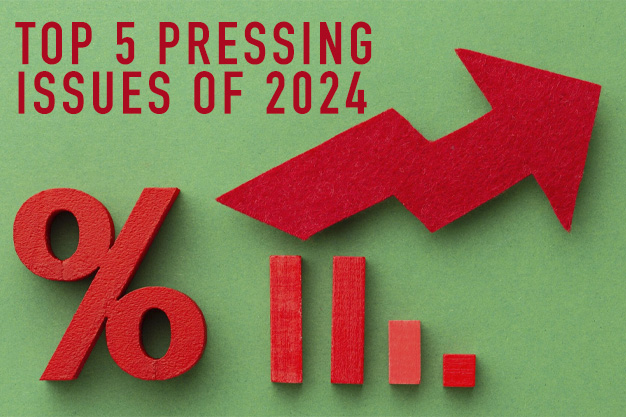
As 2023 draws to a close, now is the right time to start getting ready for 2024. This year was a roller coaster for those of us in the real estate game. From rising interest rates, a surge in renters, and a steady rise in inflation could lead to a recession. That’s why I created a list of five things to look out for that could shape the financial landscape in 2024.
1. Debt Crisis Looms:
The first significant issue on our list is the mounting debt crisis. The Federal Reserve has been rapidly increasing the federal funds rate, causing interest rates to soar. This directly impacts those with floating-rate debt, including credit cards, auto, student loans, and mortgages. As interest rates continue to rise, servicing such debt becomes increasingly expensive, pushing many individuals further away from saving and securing their financial futures.
2. The Challenge of Equity Investment:
With an abundance of money parked in risk-free savings accounts and short-term government securities, investors are presented with a problem. The attractiveness of earning 4-5% with minimal risk is putting pressure on traditional investment avenues, such as the stock market, bonds, real estate, and commodities. This competition for investment dollars will remain a challenge for anyone seeking to invest or raise capital in 2024.
3. Unemployment and Inflation
While low unemployment may seem like a positive sign, it poses challenges for the Federal Reserve. Low unemployment tends to lead to wage inflation, which is precisely what the Federal Reserve is trying to combat through the increasing federal funds rate. Projections indicate a rise in the unemployment rate from 3.7% to 4.4%, which could result in over 1 million workers losing their jobs. The Fed’s pursuit of its inflation-fighting goals may lead to higher unemployment.
4. The Rise of the Renter Nation
The homeownership rate in the United States has dropped from 69% to 65% in recent years, with more people opting for rentals. This shift has caused a surge in rental prices in many U.S. markets. Furthermore, homebuilders and multifamily builders have scaled back due to rising construction costs and interest rates. As a result, we can expect even more severe housing shortages in the coming years, leading to potential government interventions like rent control and rent caps.
5. Debt Maturities and Real Estate Values
Many individuals and businesses have borrowed substantial sums of money in recent years, and now, the time has come to repay those loans. Over $1 trillion in U.S. commercial real estate loans are maturing in 2023 and 2024, with most of this debt held in local and regional banks. This could lead to significant disruptions in the commercial lending and real estate markets. Meanwhile, interest rate increases are causing credit delinquencies to rise, adding further uncertainty to the financial landscape. Real estate values are also on a downward trend due to increasing capitalization rates, resulting in lower property valuations.
These five financial challenges are likely to have a significant impact in 2024. It’s crucial to stay informed and prepare for the potential economic shifts ahead.
